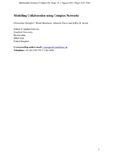JavaScript is disabled for your browser. Some features of this site may not work without it.
| dc.contributor.author | Durugbo, Christopher | - |
| dc.contributor.author | Hutabarat, Windo | - |
| dc.contributor.author | Tiwari, Ashutosh | - |
| dc.contributor.author | Alcock, Jeffrey R. | - |
| dc.date.accessioned | 2012-08-04T23:01:20Z | |
| dc.date.available | 2012-08-04T23:01:20Z | |
| dc.date.issued | 2011-08-01T00:00:00Z | - |
| dc.identifier.citation | Christopher Durugbo, Windo Hutabarat, Ashutosh Tiwari and Jeffrey R. Alcock. Modelling collaboration using complex networks. Information Sciences,Volume 181, Issue 15, 1 August 2011, Pages 3143-3161 | |
| dc.identifier.issn | 0020-0255 | - |
| dc.identifier.uri | http://dx.doi.org/10.1016/j.ins.2011.03.020 | - |
| dc.identifier.uri | http://dspace.lib.cranfield.ac.uk/handle/1826/5744 | |
| dc.description.abstract | Collaboration means working together to achieve a common goal or to solve a problem, and in modern businesses, it is an important factor for information sharing and quality. This is due to the ability of collaborations to shape the structure and behaviour of organisations through the pooling of expertise and standardising of work patterns. Grounded on complex network theory and collaborative design research, a mathematical model of information flow for analysing collaboration in organisations is proposed in this article. The model defines concepts for characterising organisational structures for collaboration and proposes indicators for assessing organisational behaviour in terms of collaboration within organisations. The article concludes by discussing the applications and limitations of the proposed model. | en_UK |
| dc.publisher | Elsevier Science B.V., Amsterdam. | en_UK |
| dc.title | Modelling collaboration using complex networks | en_UK |
| dc.type | Article | - |
Files in this item
This item appears in the following Collection(s)
-
Staff publications (SAS) [907]
